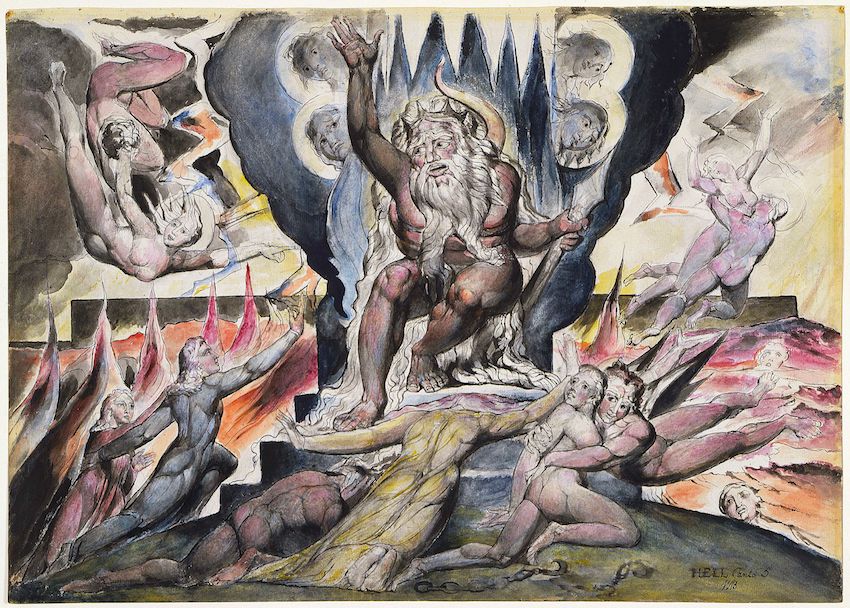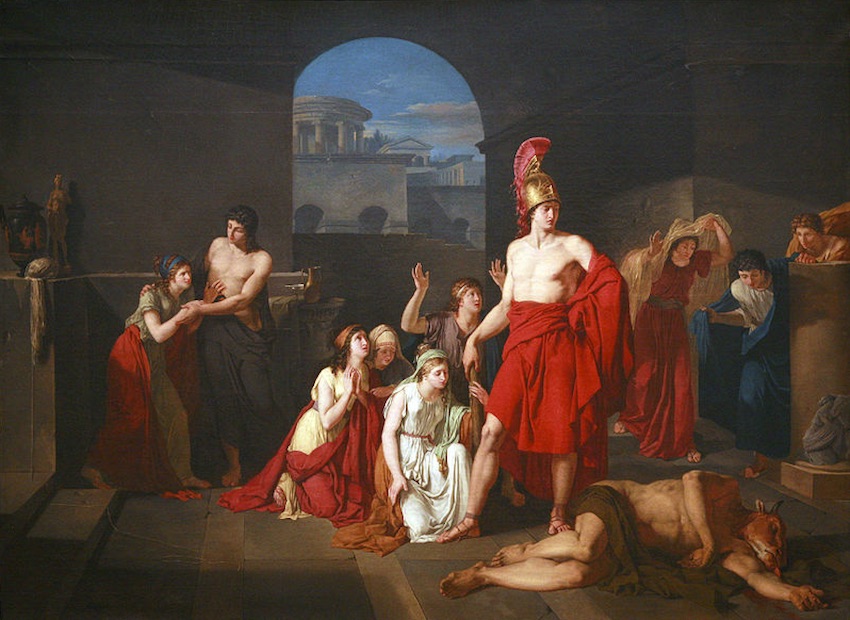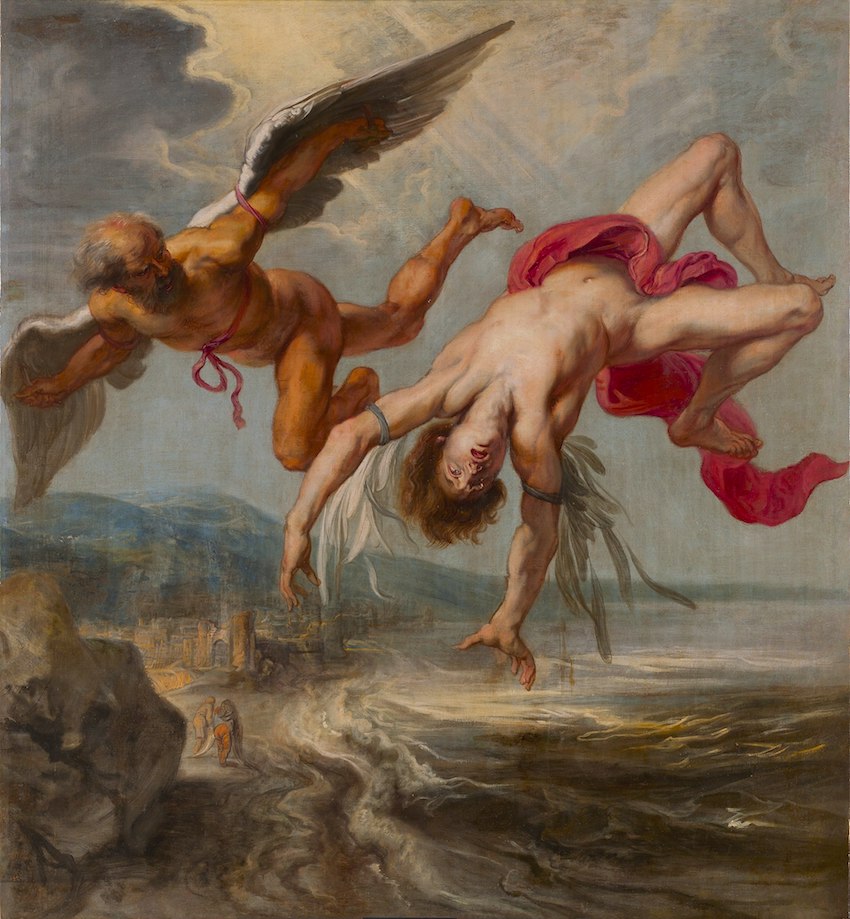Minos and His Family

Minos by William Blake, ca. 1824-7. As part of Illustrations to Dante's "Divine Comedy"
Minos had many children, four sons and four daughters (including Ariadne and Phaidra) by his wife Pasiphae (a daughter of Helios) and several by other women and nymphs. When his stepfather Asterios died, he wanted to become king of Crete, but the people demanded a sign from the gods. Minos prayed to Poseidon to send a "bull from the depths" of the sea, and promised that he would sacrifice the bull to Poseidon if it should appear. Poseidon granted Minos' request and sent a great bull from the waves to the shore, but Minos kept the bull in his herds and sacrificed another one instead.
Herodotus says that Minos was a great military leader, under whose reign Crete became the most famous of all nations. Thucydides adds that Minos was the first "thalassocrat," the first to build a navy and rule the sea. At nin-year-intervals Minos went to the cave of Zeus and returned with a new set of laws, which he called the commands of Zeus; Homer says that Minos was king for periods of nine years and "conversed with great Zeus."
Angered by Minos' failure to sacrifice the bull he had sent, Poseidon punished Minos in two ways: he made the bull mad and wild, so that no one could approach him, and he also made Minos' wife Pasiphae fall in love with the bull. Fortunately for Pasiphae the famous architect Daaidalos was living then in Crete, exiled from Athens for the murder of his young nephew Talos (whom he killed when the boy showed signs of nascent engineering talent by sawing through a piece of wood with a snake's jawbone). Although he is more famous for building the Labyrinth and making wings for himself and his son Ikaros, Daidalos' most remarkable accomplishment was what he now made for Pasiphae: a wooden framework on wheels, with a cos's skin stretched over it, constructed in such a way that Pasiphae could get inside it, pedal it to the field where the mad bull was raving, and position herself in such a way that when the bull mounted the artificial cow it would also have sex with Pasiphae inside.
Pasiphae then became pregnant by the mad bull and gave birth to the Minotaur (or Asterios), who had a human body and a bull's head. Minos, who of course wanted to conceal the product of his wife's adulterous bestiality, consulted oracles and was told to have Daidalos build an enormous maze, the Labyrinth, and to put the Minotaur in its center (from which no one could find the way out).
Meanwhile the Minotaur's father, the bull that had been sent by Poseidon, was captured by Herakles for his seventh labor and taken to Eurystheus. After its release the bull wandered around Greece and eventually came to Marathon near Athens. At this time king Aigeus of Athens was holding athletic games during the Panathenean festival, and Minos's son Androgeos came to compete and won all the events. Aigeus then sent Androgeos to fight the bull at Marathon, but the bull killed him (others said that Androgeos was killed by jealous competitors as he travelled to Thebes for other games in honor of king Laios).
When Minos heard of the death of his son, he was on the island Paros sacrificing to the Charites (the three Graces). He returned to Crete, assembled his fleet, and sailed to Athens to gain revenge for his son's death. First he conquered Megara, whose king Nisos had a magic purple hair on his head which made him immortal; Nisos' daughter Skylla fell in love with Minos and pulled the hair out of her father's head, and then Minos killed Nisos and repaid Skylla by drowning her.
Minos now invaded Athens, and the war dragged on for some time. In
response to Minos' prayer, his father Zeus afflicted Athens with plague and
famine, but the Athenians overcame this by sacrificing the four daughters of
Hyakinthos at the tomb of the Kyklops Geraistos. The Athenians then learned
from an oracle that their only hope was to pay whatever tribute Minos would
demand, and Minos ordered Athens to send to Crete every year (or every nine
years) seven young men and seven maidens to be eaten by the Minotaur.
Theseus and Ariadne

Theseus victor of the Minotaur, Charles-Édouard Chaise, oil on canvas, circa 1791. Accession number 1392.
In the meantime Theseus, son of Aigeus (or Poseidon) and Aithra, came to Athens, but his father did not recognize him. Medeia, who was staying with Aigeus at this time, warned Aigeus to beware of the stranger, so Aigeus sent Theseus to fight the bull at Marathon, figuring that Theseus would die (as Androgeos had died earlier). However Theseus killed the bull and then, after his father recognized him, volunteered to be included in the third tribute sent as food for the Minotaur.
When the fourteen Athenian youths arrived in Crete, Minos' daughter Ariadne fell in love with Theseus and asked Daidalos how she might save him. Daidalos told her that Theseus would have to fight the Minotaur, but that he could escape from the labyrinth by taking a ball of thread with him, tieing one end of the thread to the entrance, unwinding the thread as he went through the maze, and then following the thread on his way out. Theseus entered the labyrinth and did as Daidalos had advised. When he reached the center, he met the Minotaur and killed it with his fists, then fled from Crete with the other youths and with Ariadne, as he had promised her.
When Theseus reached the island of Naxos, he abandoned Ariadne while she
slept, but she was rescued by the god Dionysos, who became her lover. The
people of Cyprus said that Ariadne came with Theseus to their island, then died
of grief when Theseus' ship was carried off by storms. She subsequently was
worshipped as a goddess in the sacred grove of Aphrodite Ariadne. It is
certainly possible that Ariadne was originally a goddess, a Cretan version of
Aphrodite, and her cult was important not only on Cyprus but also, apparently,
in Macedonia, where portrayals of Ariadne and Dionysos appear frequently in the
art of the royal dynasty.
Daidalos and Ikaros

The Fall of Ikaros by Jacob Peter Gowy Madrid, Museo del Prado
Minos now punished Daidalos by imprisoning him in the labyrinth, along with his son Ikaros, bu Daidalos made artificial wings so that they could escape by flight. He warned Ikaros not to fly too high (or the sun would melt the wings' wax glue) or too near the sea (or the spray would damage the wings). Ikaros flew too near the sun, whose rays melted the wax, and he fell to his death in the sea south of Samos, the Ikarian sea. His body washed ashore on the island named Ikaria for him, where Herakles found and buried it.
Daidalos flew to Kamikos in Sicily, where king Kokalos (and his daughters) were delighted to have him stay with them. Minos set out in search of Daidalos and sailed through the Mediterranean with his navy. At every port he gave the king a spiral seashell and promised a great reward if he could find someone who could pass a thread through the shell. The challenge is reminiscent of the advice Daidalos gave Theseus, and this is exactly what Minos was thinking: if he found the man who could thread the shell, he would find Daidalos.
When Minos came to Sicily, he gave the shell to Kokalos, who returned it the next day completely threaded; Daidalos had tied the thread to an ant, who pulled it behind him all the way through the shell. Minos demanded that Kokalos turn over Daidalos to him. Either the king refused and a war ensued, in which Minos was killed, or he agreed to turn over Daidalos after a banquet. While Minos was happily bathing with the daughters of Kokalos before the feast, they poured boiling water over him and he died.
Daidalos built many wonderful works in Sicily and then went to Sardinia,
where he made the Daidaleia (perhaps Bronze Age conical towers). His name was
connected by the Greeks with the first lifelike statues (when Herakles saw the
statue of himself which Daidalos had built to honor him for burying his son,
Herakles thought it was alive and threw stones at it), and also with great
Bronze Age structures all over the world, especially in Egypt.
